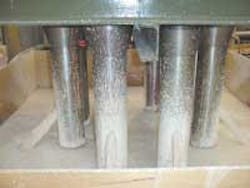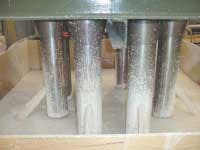Drilling & Production
Frank Hartley, Houston
HP/HT perforation in Elgin/Franklin
Located in the Central North Sea, the Elgin/Franklin project is a combined high pressure/high temperature (HP/HT) development (1,110 bar, 200°C) of two gas condensate fields. The wells have been drilled with an "S" profile to approximately 6,600 meters and offset up to 2,800 meters. The completions have been run from the jackup rigs SF Galaxy 1 (Elgin) and SF Magellan (Franklin) in cantilever mode above the wellhead platforms.
TotalFinaElf Exploration (TFE) UK PLC's completion program for the well was to install completion equipment, confirm well integrity, and then perforate through-tubing on coil-tubing, with the well balanced or slightly under-balanced. During this initial perforating campaign, five wells were perforated in the Elgin field along with an additional four wells in the Franklin field.
A one-trip perforation strategy was planned for each of the wells. The Expro Group's HP/HT correlation system provided memory data sets from each dummy run, allowing the guns to be positioned within the required depth window of +/- 1 meter. This data was used in conjunction with the coiled tubing depth control system. Also, high specification ExalHOT 392SQ gauges were run in each of the five Elgin wells and in two Franklin wells. Pressure and temperature data was used to plan the set up of gun firing heads by confirming pressures at firing depth prior to perforating and to identify fluid interfaces within the wellbore.
The HP/HT correlation system is designed for an hydrogen sulfide environment with temperatures up to 200°C and pressures up to 20,000 psi. The tools are specified to withstand such conditions for up to 30 hours and have a compressive strength of 10,000 lb force.
Besides logging on all Elgin and Franklin dummy runs, a "below guns" version of the tool was used successfully during the latter stages of the Elgin campaign. An enhanced version of the "below guns" tool was developed for the Franklin phase of the operation along with a "flow through" option for deployment above the guns.
Erosion tests for wellhead cuttings
The service life of ABB Vetco Gray's drill cuttings re-injection system will be extended, thanks to erosion research carried out by BHRSolutions. Experiments carried out at the fluid engineering center have produced wear rate information and the amount of time that the units can be left safely in service.
Changes in offshore environmental legislation require oil companies to cease discharging well drilling cuttings over the side of their drilling rigs and into the sea. Drill cuttings, under the new regulations, have to be either transported onshore for landfill disposal, which is very expensive, or re-introduced into the well.
To achieve well re-introduction, the drill cuttings injection system (DCIS) to re-inject into the subsea formation was designed. The system makes use of the Procut slurrification process, which takes oil-based drill cuttings and grinds them to form homogenous slurry for re-injection. Since the slurry is highly abrasive, a series of tests to investigate the wear properties of the DCIS was carried out at the fluid engineering center.
A test model was designed to simulate the slurry flow path through the actual equipment. In this way, an observation of actual wear of the model components could be used to estimate wear rates for the different components in the actual system. The model was constructed so that the wear resistance of three different materials could be tested simultaneously, saving both time and money for the client.
Experimental results have provided a series of wear rates, each giving an expected material loss per year of service. This information has highlighted specific locations of exceptional wear, and has provided the opportunity to reinforce these locations to extend overall system life.
Solid expandable tubular technology
Formed in 1999 as a joint venture between Shell and Halliburton, Enventure Global Technology created and defined solid expandable tubular technology (SET) and made it commercially viable. Ninety-nine percent of all existing footage of solid expandable tubulars installed in wells today was developed and manufactured by the company. The company has gone from five to 52 employees during its first three years of operations, and is projecting that number will increase to 75 by yearend 2002. Revenues are expected to exceed $15 million this year.
The fundamental benefit provided by solid expandable tubular technology is to move the final forming stage of steel tubular manufacturing downhole. Steel tubulars are to the drilling of oil and gas wells what I-beams are to building skyscrapers. This revolutionary in-situ manufacturing process enhances the probability of success of every tubular installation in every well drilled, enabling operators to access reserves that cannot be reached economically with conventional technology. SET technology provides a true step-change in the well construction process - a step-change that results in decreased well construction costs, faster production payback, and, ultimately, savings at the gas pump for the retail consumer.
The demand for this technology is growing exponentially both in the U.S. and internationally. To date, 43 solid expandable tubular systems, and expanded a total of 30,012 ft of tubulars and 823 proprietary expandable connections have been installed. This increase is spurred on by deepwater and ultra-deepwater arenas, shallow inland waters, as well as onshore subsidence and remediation projects using their openhole, cased-hole, and expandable liner hanger systems.
Borehole imager for wells drilled with nonconductive oil or synthetic-base mud
Detailed borehole images, derived from microresistivity measurements, can now be acquired in wells drilled with nonconductive oil-base mud. Images from the oil-base micro imager (OBMI) tool by Schlumberger Oilfield Services are being used to increase the accuracy of detailed geologic analysis and the interpretation of formation characteristics.
The emergence of imaging technology for oil- and synthetic-base muds is especially important to fracture analysis and mapping of small-scale structural features that until this point were difficult or almost impossible to interpret in oil-base muds.
The first imager engineered to work in all nonconductive oil- and synthetic-base muds; the OBMI tool provides a high-resolution image of the formation derived from 20 calibrated microresistivity measurements. Improved accuracy of reserves estimates (in some cases adding significant new reserves), aid in completion design, fine tune reservoir models, provide direction for sidetracking in dry wells, and "see" features that are too small, too steep, or too subtle for seismic techniques are being realized.
Microresistivity images are powerful tools for decision-making and optimum reservoir exploitation. Armed with enhanced geology and reservoir models, companies have discovered additional reserves, optimized their completions, and even changed the location of new wells in the development process.

